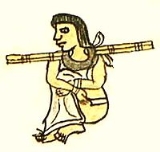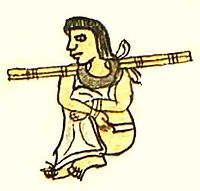
Aztec slavery
Encyclopedia
In the structure of the Aztec
or Mexica society, Slaves or tlacotin (distinct from war captives) also constituted an important class.
This slavery
was very different from what Europe
ans of the same period were to establish in their colonies, although it had much in common with the slaves of classical antiquity. First, slavery was personal, not hereditary: a slave's children were free. A slave could have possessions and even own other slaves. Slaves could buy their liberty, and slaves could be set free if they were able to show they had been mistreated or if they had children with or were married to their masters.
Typically, upon the death of the master, slaves who had performed outstanding services were freed. The rest of the slaves were passed on as part of an inheritance.
Another rather remarkable method for a slave to recover liberty was described by Manuel Orozco y Berra in La civilización azteca (1860): if, at the tianquiztli (marketplace; the word has survived into modern-day Spanish as "tianguis
"), a slave could escape the vigilance of their master, run outside the walls of the market and step on a piece of human excrement, and then present their case to the judges, who would grant freedom. They would then be washed, provided with new clothes not owned by the master, and declared free. Because a person who was not a relative of the master could be declared a slave for trying to prevent a slave's escape, people typically would not help the master prevent the slave's escape.
 Orozco y Berra also reports that a master could not sell a slave without the slave's consent, unless the slave had been classified as incorrigible by an authority. (Incorrigibility could be determined on the basis of repeated laziness
Orozco y Berra also reports that a master could not sell a slave without the slave's consent, unless the slave had been classified as incorrigible by an authority. (Incorrigibility could be determined on the basis of repeated laziness
, attempts to run away, or general bad conduct.) Incorrigible slaves were made to wear a wooden collar, affixed by rings at the back. The collar was not merely a symbol of bad conduct: it was designed to make it harder to run away through a crowd or through narrow spaces.
When buying a collared slave, one was informed of how many times that slave had been sold. A slave who was sold three times as incorrigible could be sold to be sacrificed; those slaves commanded a premium in price.
However, if a collared slave managed to present him- or herself in the royal palace or in a temple, he or she would regain liberty.
An Aztec could become a slave as a punishment
. A murderer sentenced to death could instead, upon the request of the wife of his victim, be given to her as a slave. A father could sell his son into slavery if the son was declared incorrigible by an authority. Those who did not pay their debts could also be sold as slaves.
People could sell themselves as slaves. They could stay free long enough to enjoy the price of their liberty, about twenty blankets, usually enough for a year; after that time they went to their new master. Usually this was the destiny of gamblers and of old ahuini (courtesan
s or prostitutes).
Motolinía reports that some captives, future victims of sacrifice, were treated as slaves with all the rights of an Aztec slave until the time of their sacrifice, but it is not clear how they were kept from running away.
Aztec
The Aztec people were certain ethnic groups of central Mexico, particularly those groups who spoke the Nahuatl language and who dominated large parts of Mesoamerica in the 14th, 15th and 16th centuries, a period referred to as the late post-classic period in Mesoamerican chronology.Aztec is the...
or Mexica society, Slaves or tlacotin (distinct from war captives) also constituted an important class.
This slavery
Slavery
Slavery is a system under which people are treated as property to be bought and sold, and are forced to work. Slaves can be held against their will from the time of their capture, purchase or birth, and deprived of the right to leave, to refuse to work, or to demand compensation...
was very different from what Europe
Europe
Europe is, by convention, one of the world's seven continents. Comprising the westernmost peninsula of Eurasia, Europe is generally 'divided' from Asia to its east by the watershed divides of the Ural and Caucasus Mountains, the Ural River, the Caspian and Black Seas, and the waterways connecting...
ans of the same period were to establish in their colonies, although it had much in common with the slaves of classical antiquity. First, slavery was personal, not hereditary: a slave's children were free. A slave could have possessions and even own other slaves. Slaves could buy their liberty, and slaves could be set free if they were able to show they had been mistreated or if they had children with or were married to their masters.
Typically, upon the death of the master, slaves who had performed outstanding services were freed. The rest of the slaves were passed on as part of an inheritance.
Another rather remarkable method for a slave to recover liberty was described by Manuel Orozco y Berra in La civilización azteca (1860): if, at the tianquiztli (marketplace; the word has survived into modern-day Spanish as "tianguis
Tianguis
A tianguis is an open air market or bazaar that is traditionally held on certain market days in a town or city neighborhood in Mexico and Central America. This bazaar tradition has its roots well into the pre-Hispanic period and continues in many cases essentially unchanged into the present day....
"), a slave could escape the vigilance of their master, run outside the walls of the market and step on a piece of human excrement, and then present their case to the judges, who would grant freedom. They would then be washed, provided with new clothes not owned by the master, and declared free. Because a person who was not a relative of the master could be declared a slave for trying to prevent a slave's escape, people typically would not help the master prevent the slave's escape.

Laziness
Laziness is a disinclination to activity or exertion despite having the ability to do so. It is often used as a pejorative; related terms for a person seen to be lazy include couch potato, slacker, and bludger....
, attempts to run away, or general bad conduct.) Incorrigible slaves were made to wear a wooden collar, affixed by rings at the back. The collar was not merely a symbol of bad conduct: it was designed to make it harder to run away through a crowd or through narrow spaces.
When buying a collared slave, one was informed of how many times that slave had been sold. A slave who was sold three times as incorrigible could be sold to be sacrificed; those slaves commanded a premium in price.
However, if a collared slave managed to present him- or herself in the royal palace or in a temple, he or she would regain liberty.
An Aztec could become a slave as a punishment
Punishment
Punishment is the authoritative imposition of something negative or unpleasant on a person or animal in response to behavior deemed wrong by an individual or group....
. A murderer sentenced to death could instead, upon the request of the wife of his victim, be given to her as a slave. A father could sell his son into slavery if the son was declared incorrigible by an authority. Those who did not pay their debts could also be sold as slaves.
People could sell themselves as slaves. They could stay free long enough to enjoy the price of their liberty, about twenty blankets, usually enough for a year; after that time they went to their new master. Usually this was the destiny of gamblers and of old ahuini (courtesan
Courtesan
A courtesan was originally a female courtier, which means a person who attends the court of a monarch or other powerful person.In feudal society, the court was the centre of government as well as the residence of the monarch, and social and political life were often completely mixed together...
s or prostitutes).
Motolinía reports that some captives, future victims of sacrifice, were treated as slaves with all the rights of an Aztec slave until the time of their sacrifice, but it is not clear how they were kept from running away.

